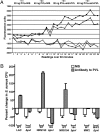Antibody-mediated enhancement of community-acquired methicillin-resistant Staphylococcus aureus infection
- PMID: 20133867
- PMCID: PMC2836673
- DOI: 10.1073/pnas.0910344107
Antibody-mediated enhancement of community-acquired methicillin-resistant Staphylococcus aureus infection
Abstract
Community-acquired infections caused by methicillin-resistant Staphylococcus aureus (MRSA) expressing the Panton-Valentine leukocidin (PVL) are rampant, but the contribution of PVL to bacterial virulence remains controversial. While PVL is usually viewed as a cytotoxin, at sublytic amounts it activates protective innate immune responses. A leukotoxic effect might predominate in high inoculum studies, whereas protective proinflammatory properties might predominate in settings with lower bacterial inocula that more closely mimic what initially occurs in humans. However, these protective effects might possibly be neutralized by antibodies to PVL, which are found in normal human sera and at increased levels following PVL(+) S. aureus infections. In a low-inoculum murine skin abscess model including a foreign body at the infection site, strains deleted for the pvl genes replicated more efficiently within abscesses than isogenic PVL(+) strains. Coinfection of mice at separate sites with isogenic PVL(+) and PVL(-) MRSA abrogated the differences in bacterial burdens, indicating a systemic effect on host innate immunity from production of PVL. Mice given antibody to PVL and then infected with seven different PVL(+) strains also had significantly higher bacterial counts in abscesses compared with mice given nonimmune serum. Antibody to PVL had no effect on MRSA strains that did not produce PVL. In vitro, antibody to PVL incapacitated PVL-mediated activation of PMNs, indicating that virulence of PVL(+) MRSA is enhanced by the interference of PVL-activated innate immune responses. Given the high rates of primary and recurring MRSA infections in humans, it appears that antibodies to PVL might contribute to host susceptibility to infection.
Conflict of interest statement
The authors declare no conflict of interest.
Figures




Similar articles
-
High levels of antibody to panton-valentine leukocidin are not associated with resistance to Staphylococcus aureus-associated skin and soft-tissue infection.Clin Infect Dis. 2010 Nov 15;51(10):1138-46. doi: 10.1086/656742. Epub 2010 Oct 14. Clin Infect Dis. 2010. PMID: 20946065 Free PMC article.
-
Staphylococcus aureus corneal infections: effect of the Panton-Valentine leukocidin (PVL) and antibody to PVL on virulence and pathology.Invest Ophthalmol Vis Sci. 2013 Jul 1;54(7):4430-8. doi: 10.1167/iovs.13-11701. Invest Ophthalmol Vis Sci. 2013. PMID: 23737477 Free PMC article.
-
[Investigation of SCCmec types and Panton-Valentine leukocidin in community-acquired and nosocomial Staphylococcus aureus strains: comparing skin and soft tissue infections to the other infections].Mikrobiyol Bul. 2012 Jul;46(3):341-51. Mikrobiyol Bul. 2012. PMID: 22951646 Turkish.
-
Enhancement of bacterial virulence by antibody neutralization of immune-activating toxins.Virulence. 2010 Sep-Oct;1(5):409-13. doi: 10.4161/viru.1.5.12705. Virulence. 2010. PMID: 21178480 Review.
-
Community-acquired necrotizing pneumonia caused by methicillin-resistant Staphylococcus aureus producing Panton-Valentine leukocidin in a Chinese teenager: case report and literature review.Int J Infect Dis. 2014 Sep;26:17-21. doi: 10.1016/j.ijid.2014.02.025. Epub 2014 Jun 26. Int J Infect Dis. 2014. PMID: 24980464 Review.
Cited by
-
Panton-Valentine leukocidin is not the primary determinant of outcome for Staphylococcus aureus skin infections: evaluation from the CANVAS studies.PLoS One. 2012;7(5):e37212. doi: 10.1371/journal.pone.0037212. Epub 2012 May 18. PLoS One. 2012. PMID: 22623995 Free PMC article.
-
Antibody-based intervention against the pore-forming toxins of Staphylococcus aureus.Virulence. 2018 Dec 31;9(1):645-647. doi: 10.1080/21505594.2017.1421831. Virulence. 2018. PMID: 29405823 Free PMC article. No abstract available.
-
Colonization, pathogenicity, host susceptibility, and therapeutics for Staphylococcus aureus: what is the clinical relevance?Semin Immunopathol. 2012 Mar;34(2):185-200. doi: 10.1007/s00281-011-0300-x. Epub 2011 Dec 11. Semin Immunopathol. 2012. PMID: 22160374 Free PMC article. Review.
-
The potential use of toxin antibodies as a strategy for controlling acute Staphylococcus aureus infections.Expert Opin Ther Targets. 2012 Jun;16(6):601-12. doi: 10.1517/14728222.2012.682573. Epub 2012 Apr 25. Expert Opin Ther Targets. 2012. PMID: 22530584 Free PMC article. Review.
-
Staphylococcus aureus leukotoxin GH promotes formation of neutrophil extracellular traps.J Immunol. 2013 Dec 15;191(12):6022-9. doi: 10.4049/jimmunol.1301821. Epub 2013 Nov 4. J Immunol. 2013. PMID: 24190656 Free PMC article.
References
-
- Francis JS, et al. Severe community-onset pneumonia in healthy adults caused by methicillin-resistant Staphylococcus aureus carrying the Panton-Valentine leukocidin genes. Clin Infect Dis. 2005;40:100–107. - PubMed
-
- Gorak EJ, Yamada SM, Brown JD. Community-acquired methicillin-resistant Staphylococcus aureus in hospitalized adults and children without known risk factors. Clin Infect Dis. 1999;29:797–800. - PubMed
-
- Herold BC, et al. Community-acquired methicillin-resistant Staphylococcus aureus in children with no identified predisposing risk. JAMA. 1998;279:593–598. - PubMed
-
- Naimi TS, et al. Comparison of community- and health care–associated methicillin-resistant Staphylococcus aureus infection. JAMA. 2003;290:2976–2984. - PubMed
-
- Gillet Y, et al. Association between Staphylococcus aureus strains carrying gene for Panton-Valentine leukocidin and highly lethal necrotising pneumonia in young immunocompetent patients. Lancet. 2002;359:753–759. - PubMed
Publication types
MeSH terms
Substances
Grants and funding
LinkOut - more resources
Full Text Sources
Other Literature Sources
Medical

